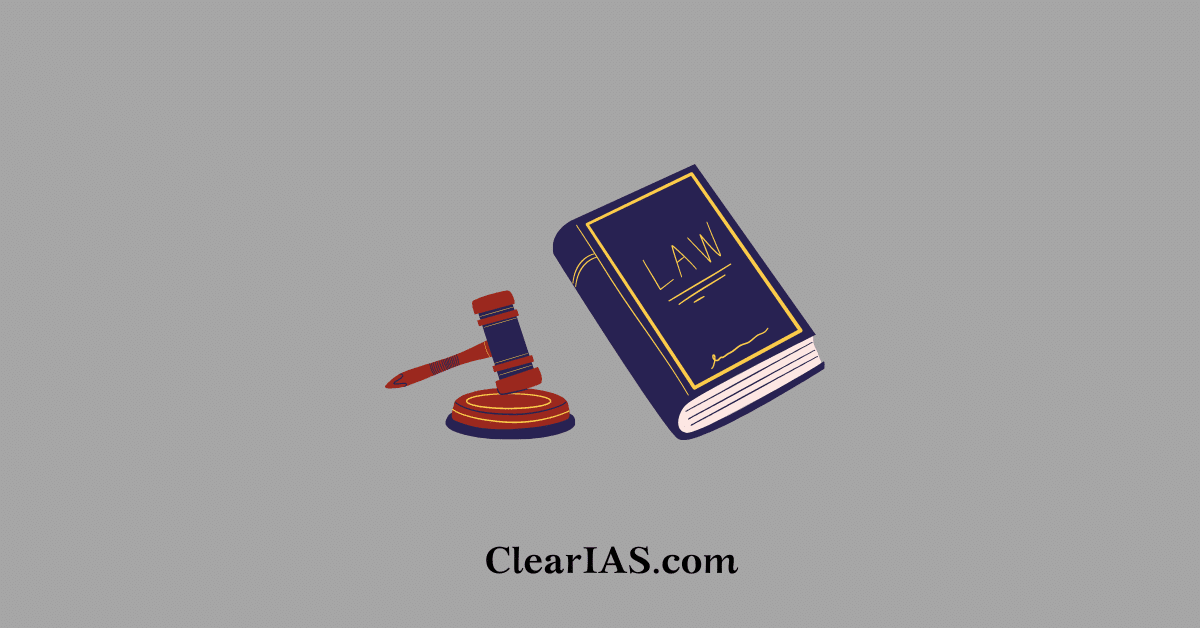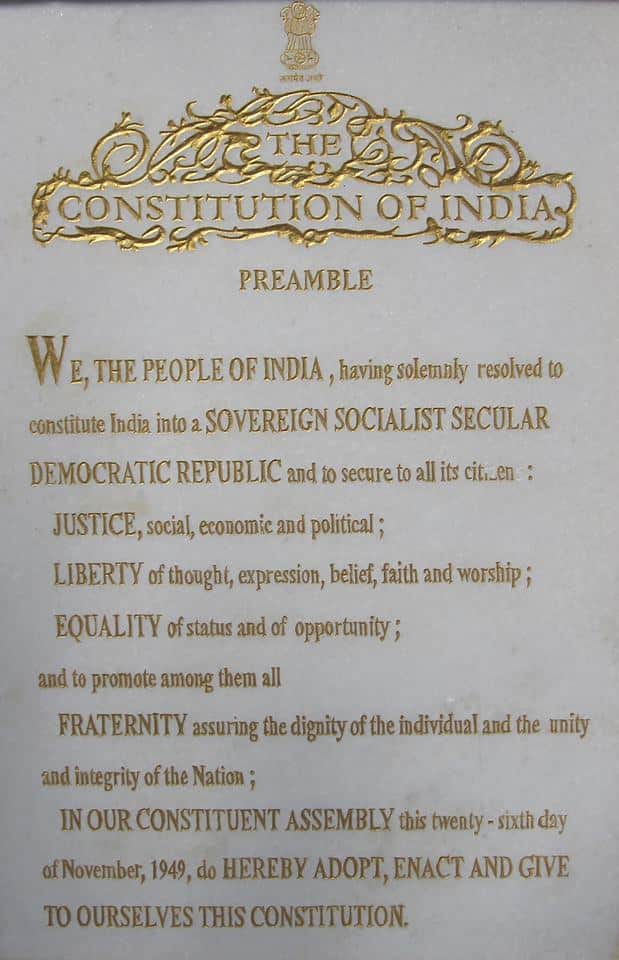
This post, Preamble to the Indian Constitution, is a part of our new ambitious article series on Indian Constitution and Polity, covering all the important topics from Article 1 to Article 395.
We have already published a mega-post listing all the articles (1-395) of the Constitution of India arranged under their respective chapters and parts.
In the coming posts, we plan to elaborate on each sub-topic. Our basis of discussion will be the Constitution of India.
Each post will discuss articles taken from Constitution first. Their explanations, questions and concepts follow in the later part of each post.
Aspirants are advised to revisit each of the coming posts time and time again, as we may update posts with current events related to the Indian Consitution.
We hope this article series greatly benefit all aspirants to prepare well for Prelims and Mains under our Prelims cum Mains Integrated approach. So let’s start well with the Preamble.
Also read: Impartiality and Non-Partisanship
The preamble to the Indian Constitution

The preamble to the Constitution of India is a brief introductory statement that sets out the guiding purpose, principles and philosophy of the constitution. The preamble gives an idea about the following: (1) the source of the constitution, (2) the nature of the Indian state (3) a statement of its objectives and (4) the date of its adoption.
WE, THE PEOPLE OF INDIA, having solemnly resolved to constitute India into a SOVEREIGN SOCIALIST SECULAR DEMOCRATIC REPUBLIC and to secure to all its citizens:
JUSTICE, social, economic and political;
LIBERTY of thought, expression, belief, faith and worship;
EQUALITY of status and of opportunity;
and to promote among them all
FRATERNITY assuring the dignity of the individual and the unity and integrity of the Nation;
IN OUR CONSTITUENT ASSEMBLY this twenty-sixth day of November, 1949, DO HEREBY ADOPT, ENACT AND GIVE TO OURSELVES THIS CONSTITUTION.
Source of the Constitution
Note: Subscribe to the ClearIAS YouTube Channel to learn more.
We, the people of India.
The phrase “We the people of India” emphasises that the constitution is made by and for the Indian people and not given to them by any outside power.
It also emphasizes the concept of popular sovereignty as laid down by Rousseau: All the power emanates from the people and the political system will be accountable and responsible to the people.
Nature of Indian state
- Sovereign: India is internally and externally sovereign – externally free from the control of any foreign power and internally, it has a free government that is directly elected by the people and makes laws that govern the people. No external power can dictate the government of India.
- Socialist: “Socialism” is an economic philosophy where means of production and distribution are owned by the State. India adopted Mixed Economy, where apart from the state, there will be private production too. Socialism as a social philosophy stresses more on societal equality.
- Secular: Features of secularism as envisaged in the Preamble is to mean that the state will have no religion of its own and all persons will be equally entitled to the freedom of conscience and the right freely to profess, practice and propagate the religion of their choice. (S R Bommai and Others v Union of India, AIR 1994 SC 1918)
- Democratic: Indicates that the Constitution has established a form of government that gets its authority from the will of the people. The rulers are elected by the people and are responsible to them.
- Republic: As opposed to a monarchy, in which the head of state is appointed on the hereditary basis for a lifetime or until he abdicates from the throne, a democratic republic is an entity in which the head of state is elected, directly or indirectly, for a fixed tenure. The President of India is elected by an electoral college for a term of five years. The post of the President Of India is not hereditary. Every citizen of India is eligible to become the President of the country.
Objectives of Indian State
- Justice: Social, Economic and Political.
- Equality: of status and opportunity.
- Liberty: of thought, expression, belief, faith and worship
- Fraternity (=Brotherhood): assuring the dignity of the individual and the unity and integrity of the nation.
Date of its adoption
The date of adoption of the Constitution is 26th November 1949. But most of the articles in the Constitution came into force on January 26th, 1950. Those articles which came into existence on 26th November 1949 is given by Article 394.
Article 394 states that this article (394) and articles 5, 6, 7, 8, 9, 60, 324, 366, 367, 379, 380, 388, 391, 392 and 393 shall come into force at once, and the remaining provisions of this Constitution shall come into force on the twenty-sixth day of January 1950, which day is referred to in this Constitution as the commencement of this Constitution.
26 January was selected for this purpose because it was this day in 1930 when the Declaration of Indian Independence (Purna Swaraj) was proclaimed by the Indian National Congress.
Info Bits related to Preamble of Indian Constitution
- Who was the Calligrapher of the Indian Constitution: Prem Behari Narain Raizada (1901–1966) was the calligrapher who hand-wrote the Constitution of India.
- Who was the chief artist behind the illustration of the original Indian Constitution: Nandalal Bose took up the historic task of beautifying/decorating the original manuscript of the Constitution of India. He was assisted by his disciple Beohar Rammanohar Sinha.
- Who designed and decorated the Preamble page of the Indian Constitution: The preamble page, along with other pages of the original Constitution of India, was designed and decorated solely by renowned painter Beohar Rammanohar Sinha of Jabalpur.
- Supreme Court of India has, in the Kesavananda case, recognised that the preamble may be used to interpret ambiguous areas of the constitution where differing interpretations present themselves. (In the 1995 case of Union Government Vs LIC of India also the Supreme Court has once again held that Preamble is an integral part of the Constitution.
- As originally enacted the preamble described the state as a “sovereign democratic republic”. In 1976 the Forty-second Amendment changed this by adding words socialist and secular to read “sovereign socialist secular democratic republic”.






Can you send me web- location where experts give their opinion on current issues?? Plz help me and plz help me how can I do online preparation ??
“Date of adoption of the Constitution is 26th November, 1950. But most of the articles in Constitution came into force on January 26th, 1950.”
In the above statement the date of adoption of the Constitution should be 26th November 1949 and not 1950. please correct it.
@Santhosh: Thanks for pointing out the typo. We have updated the same. Welcome more feedback like this.
brother you should have to go through the preamble first itself,it stated that
IN OUR CONSTITUENT ASSEMBLY this twenty six day of november,1949 do HEREBY ADOPT,ENACT AND GIVE TO OUR SELVES THIS CONSTITUTION.
Intergrity is also added along with Unity in 42 amd act, 1976
y cant u just upload lectures of these topics in youtube it is much usefel for us
can judiciary make laws ?
No its only adjudicating body in the democratic process
judgement passed by supreme court is itself a law.
It is the job of legislatures to make laws. Judiciary only protect our constitutional rights !
How come Secularism in India and SR Bommai Case are related to each other,kindly explain?
Explain the schedules of preamble
Is it enough for upsc about preamble
For UPSC nothing is enough the more u study the more u get closer to UPSC
I think the decorations and artworks in the Constitution were done under the supervision of Nandlal Bose from shantiniketan. Beohar Rammonohar Sinha was among the disciples of Nandlal Bose who worked on the Constitution under the supervision of Nandlal Bose. Though Beohar Rammonohar Sinha decorated the preamble solely thus a singnature as ‘Ram’ can be seen at the bottom right corner of the preamble page.
So, it would be incorrect to say “The preamble-page, along with other pages of the original Constitution of India, was designed and decorated solely by renowned painter Beohar Rammanohar Sinha of Jabalpur”. (The solely and the other pages should be removed).
Very much useful.
How can we aware with all general awareness on exact time ,,,if you can do anything regarding to upsc please help to online study
The 42nd Amendment Act also added the word “INTEGRITY” as it was not in the original PREAMBLE.
This is incorrect. The preamble does not have the word “Socialist” in it. Bjp is a socialist party and that is a different thing.
Can you explain about Lic of India vs Union of India case